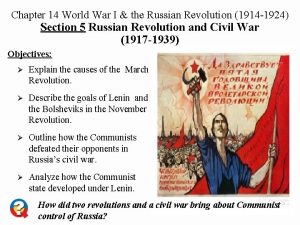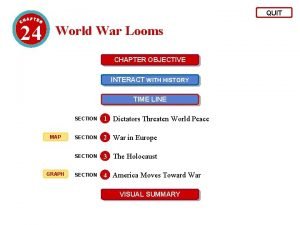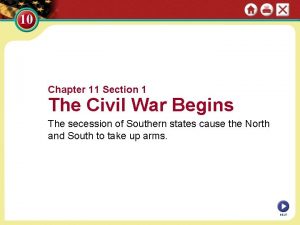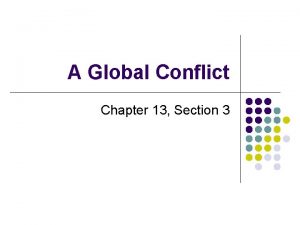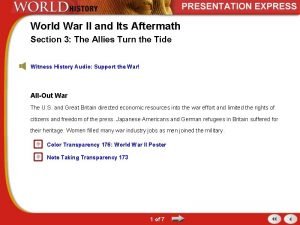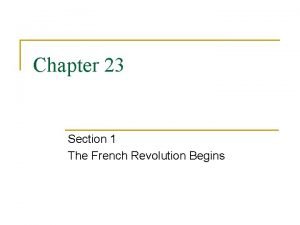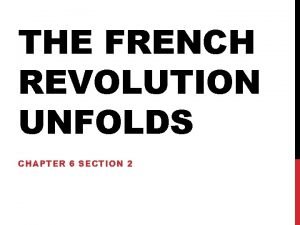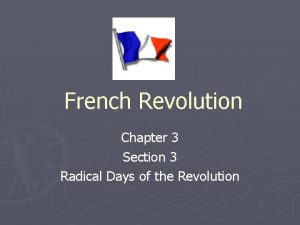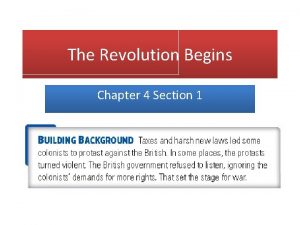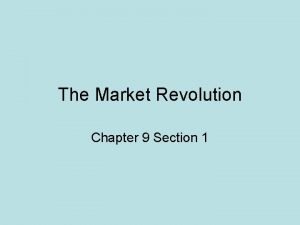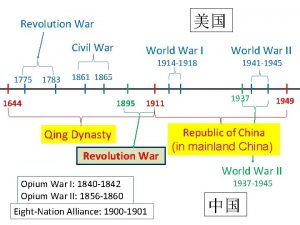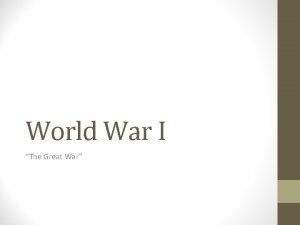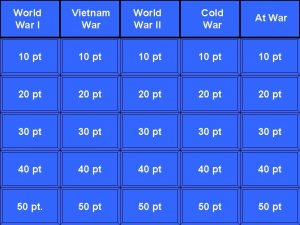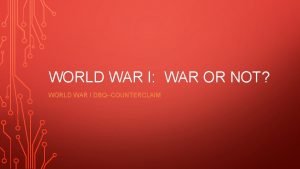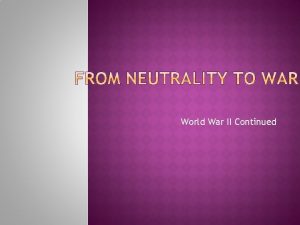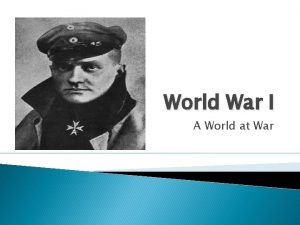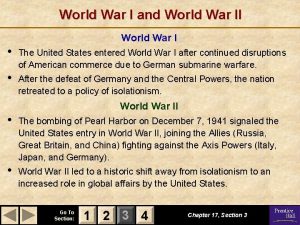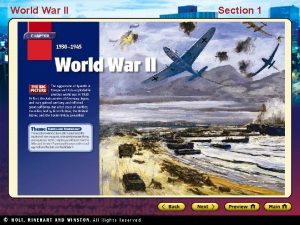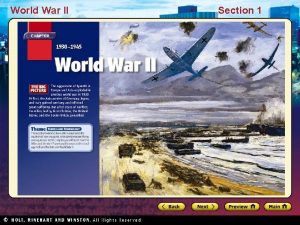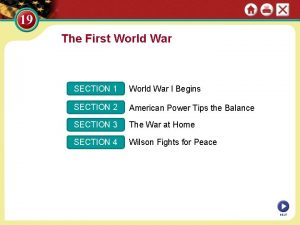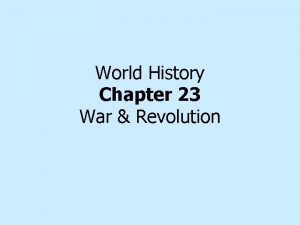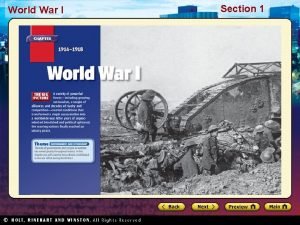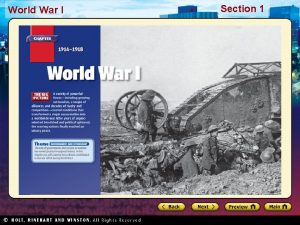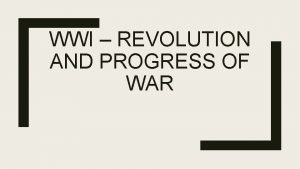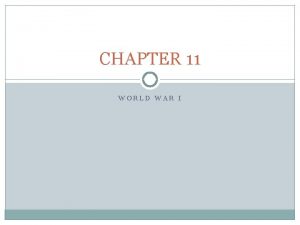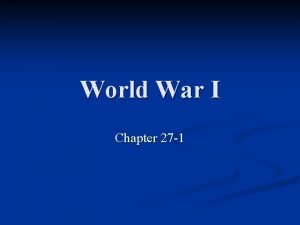Chapter 26 World War I Section 3 Revolution



















- Slides: 19

Chapter 26: World War I Section 3 – Revolution in Russia

Russia and World War I The Years Before the War Russia a troubled nation Czar Nicholas II had promised reform after 1905 revolution, but delivered little real change l Bolsheviks sought to change life through revolution, wanted to overthrow czar l Led by Lenin, wanted proletariat to rule Russia as socialist country l l Czar Nicholas II

Bolshevik Plan Adaptation of Marxist ideas of overthrow of capitalism l Wanted elite group to keep much of power over Russia l As Russia’s problems grew more serious, Bolsheviks gained more followers l Czar Nicholas hoped World War I would cause people to rally to his leadership l

Russia in World War I At the start of the war, Russia had an enormous army of some 6 million soldiers. Preparations for War l Outbreak of fighting caused patriotism, rush to join military l Otherwise Russia illprepared for war Factories unable to produce supplies quickly l Transportation system weak l Equipment outdated l On the Battlefield l Many Russian officers advanced on connections, not ability l Some initial successes on battlefield l Losses soon outnumbered victories l Millions of Russian soldiers wounded, killed during early battles

Conditions Grow Worse l Czar Nicholas II took personal command of forces, 1915 Move made little sense since he knew little of military matters l Czar’s fate became linked with fate of Russian armed forces l Bad situation grew worse under Czar’s command l l Russian army seemed doomed Central Powers were able to stop Russian offensive l Destroyed Russian soldiers’ faith in leadership l Army had little strength, even less confidence l l Conditions in Russia worse than on battlefield Food, goods scarce; peasants grew desperate l Unpopular Czarina relied on Grigori Rasputin, viewed as corrupt, immoral l Shaky support for Russian monarchy dipped even lower l

Grigori Rasputin

The Russian Revolution l By the end of 1916, Russia was once again on the edge of a revolution. As the new year began and conditions in Russia continued to worsen, the Russian people clearly wanted a change.

Revolution Begins l Citizens protested in streets of Petrograd, March 8, 1917 l Police, soldiers refused to shoot rioters l Government was helpless


Czar Nicholas II l Ordered legislature to disband l His order defied l Citizens, government, military refused to obey Czar l Forced to abdicate, March 15, 1917

Calendar Change l March revolution known as February Revolution l Russian calendar at time 13 days behind l New calendar adopted, 1918

The Russian Revolution Provisional Government l Duma established temporary government l a legislative body in the ruling assembly of Russia and of some other republics of the former Soviet Union. Led by Aleksandr Kerensky l Many unhappy with new leadership l Bolshevism Abolish private property l Enforce social equality l Later known as Marxism -Leninism l

The Russian Revolution l Bolsheviks Led opposition to Kerensky’s provisional government l Wanted fundamental change in government and society l Planned Marxist revolution l l Vladimir Lenin Bolshevik leader forced to live outside Russia l Returned, April 1917 l Germany hoped Lenin would weaken Russian war effort l

The Bolshevik Revolution Kerensky’s final offensive l Kerensky ordered final military offensive against Central Powers along Eastern Front, mid-1917 l Drive failed and led to widespread rebellion in Russian army l Weakened Russian army collapsed

The Bolshevik Revolution Bolshevik takeover Lenin became leader Conditions ideal for Lenin l Armed Bolshevik factory workers, Red Guard, attacked provisional government, November 1917 l Known as October Revolution l Kerensky’s government collapsed after nearly bloodless struggle l l Established radical Communist program l Made private ownership of land illegal l Land given to peasants l Control of factories given to workers

After the Revolution Vladimir Lenin l Lenin sought to end Russian involvement in World War I l Sent Leon Trotsky to negotiate peace with Central Powers l Russia’s army virtually powerless l Trotsky had to accept agreement harsh on Russia l Russia gained peace, gave up large parts of empire

After the Revolution Reaction to Treaty l Bolsheviks’ acceptance of peace treaty angered many Russians l Bolsheviks’ opponents organized the White Army l White Army included army leaders, political opponents, wealthy Russians opposed to Communist system Civil War l White Army received military help from France, U. S. l Civil War raged for 3 years between Lenin’s Red Army and White Army l Millions of Russians died in fighting, famines l Bolsheviks finally triumphed, late 1920

New Economic Policy l Collapsing economy Brought on by civil war, pushed Russia to edge of total ruin l Peasants, workers especially hard hit l Lenin introduced New Economic Policy, 1921 l l Key points New Economic Policy permitted some capitalist activity l Peasants could sell food at profit l Tried to encourage badly needed food production l l The Soviet Union Russia reunited with several neighboring lands, became Union of Soviet Socialist Republics, dominated by Communist leadership l Lenin’s death in 1924 led to struggle for control of Soviet Union l

END
 World war 1 and the russian revolution chapter 27
World war 1 and the russian revolution chapter 27 Chapter 14 world war 1 and the russian revolution
Chapter 14 world war 1 and the russian revolution Chapter 24 world war looms section 1 answers
Chapter 24 world war looms section 1 answers World war looms chapter 24
World war looms chapter 24 Chapter 11 section 1
Chapter 11 section 1 World war 1 begins chapter 11 section 1
World war 1 begins chapter 11 section 1 A global conflict chapter 13 section 3
A global conflict chapter 13 section 3 Chapter 19 section 1 world war 1 begins
Chapter 19 section 1 world war 1 begins World war ii and its aftermath section 1 quiz
World war ii and its aftermath section 1 quiz Chapter 30 the war to end war
Chapter 30 the war to end war Chapter 30 the war to end war
Chapter 30 the war to end war The scientific revolution chapter 6 section 1
The scientific revolution chapter 6 section 1 Chapter 7 section 1 the french revolution begins
Chapter 7 section 1 the french revolution begins Chapter 23 section 1 the french revolution begins worksheet
Chapter 23 section 1 the french revolution begins worksheet Chapter 6 section 2 the french revolution unfolds
Chapter 6 section 2 the french revolution unfolds Chapter 6 section 4 the american revolution
Chapter 6 section 4 the american revolution Red “liberty caps and tricolor”
Red “liberty caps and tricolor” May 1775
May 1775 Chapter 9 section 1 the market revolution
Chapter 9 section 1 the market revolution Chapter 6 section 4 the american revolution
Chapter 6 section 4 the american revolution

